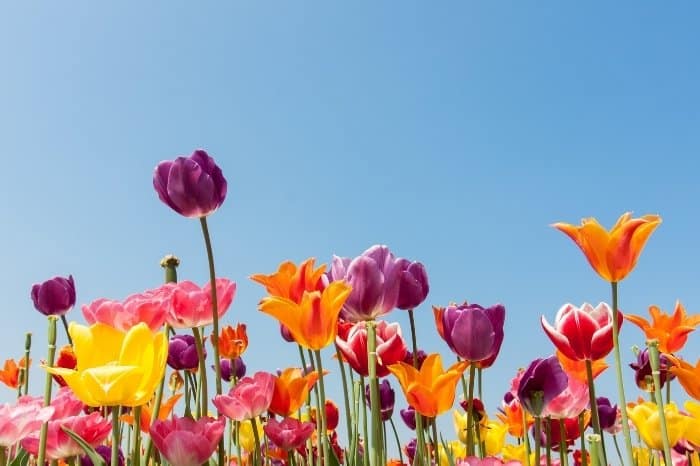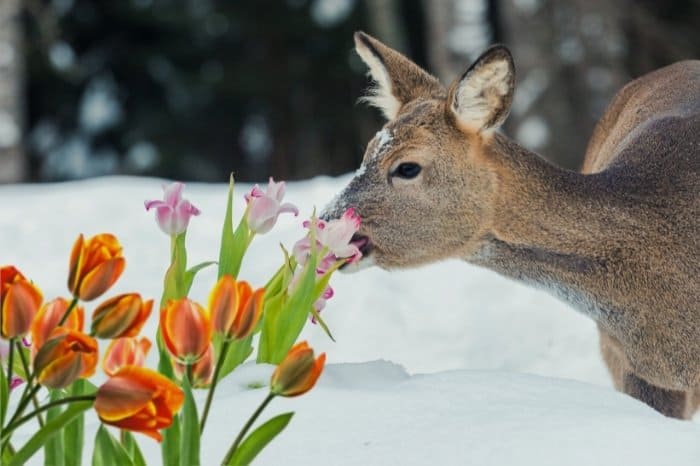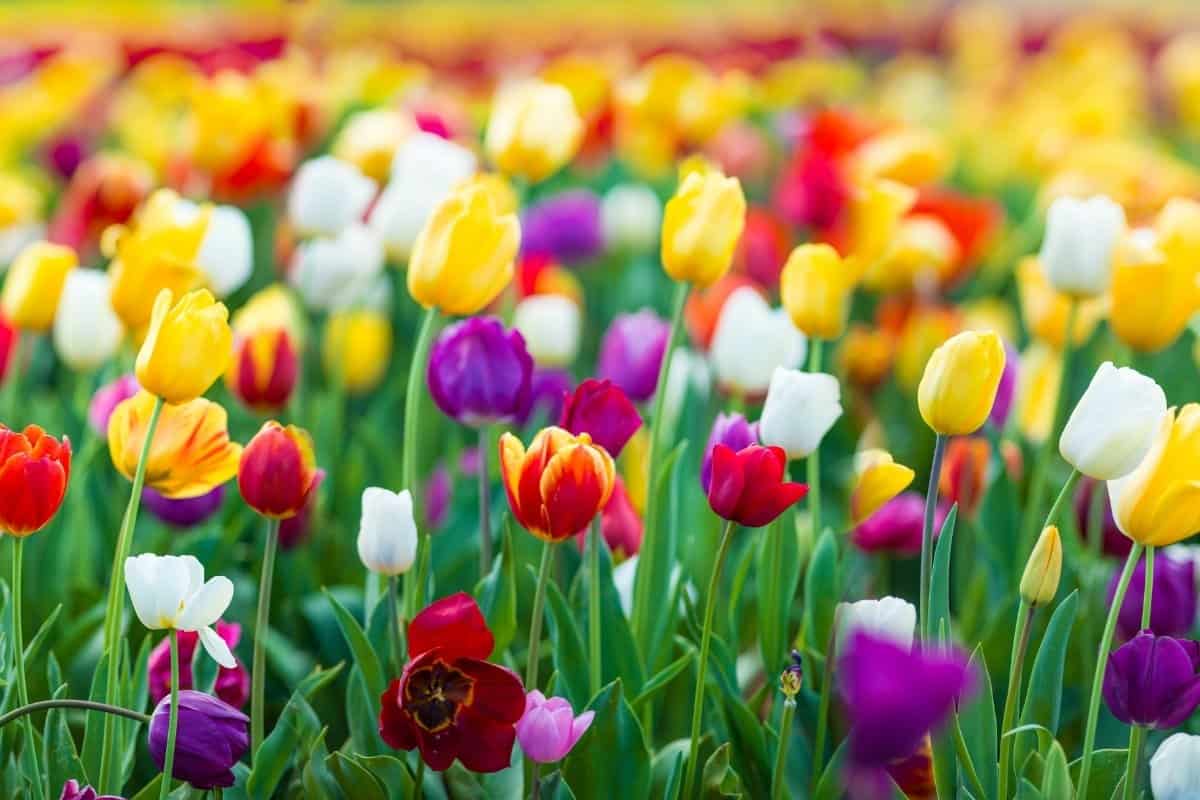Last Updated on July 4, 2021 by Cristina
You can enjoy beautiful tulips display each spring with proper planning and care, but you might wonder when you should plant tulips?
The tulip is a brightly colored flower that brightens even the dull days in early spring. Every gardener looks forward to seeing the beautiful bloom in early spring. In some way, these flowers brighten life again after the dull winter exits. They are the first to emerge after the long winter.
Tulips do well in USDA zones 4 through 10 and are best suited for planting in the fall but can also be planted at other times of the year.
Tulips and daffodils are two flowers able to tolerate cold temperatures. These flowers emerge from the ground in late winter or early spring, depending on when they were planted. In case winter temperatures return, they usually delay growth. As a result, it discourages additional growth and protects the foliage from extreme cold.
What Do Tulips Look Like?
Tulip flowers are cup-shaped with three colorful petals and three sepals. They come in various sizes, from small species that grow in natural woodland areas to larger tulips that commonly grow in gardens.
These upright flowers could be single or double and vary in cups, bowls, goblets, and more forms. Their height ranges from 6 inches to 2 feet tall. A tulip grows on each stem with 2 – 6 broad leaves per stem.

Are Tulip Bulbs Annual Or Perennial Bulbs?
Tulips were originally a perennial, meaning they could come back year after year. However, with many years of hybridizing, their ability to come back year after year has weakened. Therefore, many gardeners treat them as annuals and plant new bulbs every season.
Some places like North America and Southern Russia do not allow tulips to regrow. At the same time, the Western mountain region of the US has more success re-growing their tulips as perennials.
When To Plant Tulips?
Tulip bulbs are best planted in the fall. The soil needs to be cool from the summer temperatures before you plant. This means you can plant in September in the cold climates for zones 3 to 5, October for zones 6 to 7, and November or December for zones 8 to 9. Always check the soil temperature using a soil thermometer to be sure it is 60 degrees Fahrenheit.
Planting In The Fall
The best time to plant tulip bulbs is in the fall to get spring blooms. Tulips can be planted in the autumn before the ground freezes. However, be sure the summer warmth has cooled off before planting them. By planting various tulips spaced out in the planting season, you can have blooms starting early to late spring.
Some types can also bloom indoors as the summer temperatures begin to rise. Tulips are beautiful to have indoors, just as they are beautiful in the vases, so go ahead and include some indoors.
Selecting The Best Site To Plant Tulips
The process of how to grow tulips is straightforward. Now that you know when to plant let’s see what site you should plant on.
-
Site Selection. You can grow your tulips in mixed perennial beds, borders, foundation plantings, under trees, or even rock gardens.
-
Planting. Plant your tulips in an area that receives full or part sun for them to bloom. Planting under trees that are heavily shaded in summer will be fine. The bulbs bloom in early spring before the trees produce lots of leaves. Your tulips will get more sun in the spring compared to summer.
-
Healthy Soil. Healthy tulips need healthy soil to thrive. Tulips love well-drained soils, so check your soils before planting. Tulips are easy to grow as long as you have the correct temperatures and good soil. If your soil is prone to water retention, there is a high chance of your bulbs rotting.
-
Test Soil. Do a soil test to check if your soil drains well. The easiest way to do it is to dig a hole of about 12-inches and fill it with water. If the water takes longer than 60 minutes to drain, the soil is not well-draining.
-
Well-Drained Soil. If your soil is not well-draining, you can add compost, kelp meal, humus, or plant starter mix to improve the soil drainage.
-
Watering Your Tulips. Water your tulips once a week, giving each area a thorough soaking. This should go on for the whole first month after planting. After this, leave the plants alone until springtime. Start watering again in springtime when the leaves appear.
Miracle-Gro Indoor Potting Mix 6 qt., Grows beautiful Houseplants
You Can Plant Tulips Indoors
Did you know you can harvest your tulips when they are still tight? The petals may have a greenish look on them, but you should be able to tell what color they will be even in their green state.
Place your cut tulips in room temperature water in a vase. Tulips will continue to grow, and their bloom will open up to a bright, colorful flower. Cut tulips last longer if you add something like miracle-gro and change their water every couple of days.
Read more about Beautiful Flowers by Clicking Here:
Protecting Your Tulips From Deer
The biggest challenge to growing tulips is deer eating your flowers just when they are ready to bloom. Or the squirrels digging up the bulbs. To protect your tulips, you should put a chicken wire around your tulips to keep the squirrels away.
For deer, it’s best to install a fence at least 8 feet tall to protect your flowers and vegetables too. You can also grow daffodil or crown imperial bulbs that deer do not eat. You can also spray deer-repellant all over your garden to keep these destructive animals away.

When To Plant Tulip Bulbs Conclusion
After your tulips bloom in spring and die off, it’s best to cut back the flower stalk at the base to allow wit to come back next year. At the same time, some may not come back because they are hybrid. It’s best to try and see if your type can grow again before doing away with it.
If you know your bulbs are hybrid, go ahead and pull them out and compost them. Get ready for new bulbs in the coming season.
Otherwise, have fun growing these beauties and enjoy bringing them indoors for a bright early springtime!
Caroline is a gardener who loves to get down to the nitty–gritty of gardening. She proudly proclaims herself as a ‘dirt worshipper‘ and can often be found deep in the garden, covered in soil and singing to her plants. As a self–proclaimed ‘plant whisperer‘, Caroline believes that plants need love and attention just like any other living thing, and she loves to give them both. When she‘s not tending to her garden, you can often find her researching the latest gardening trends, or teaching others how to make their gardens thrive


